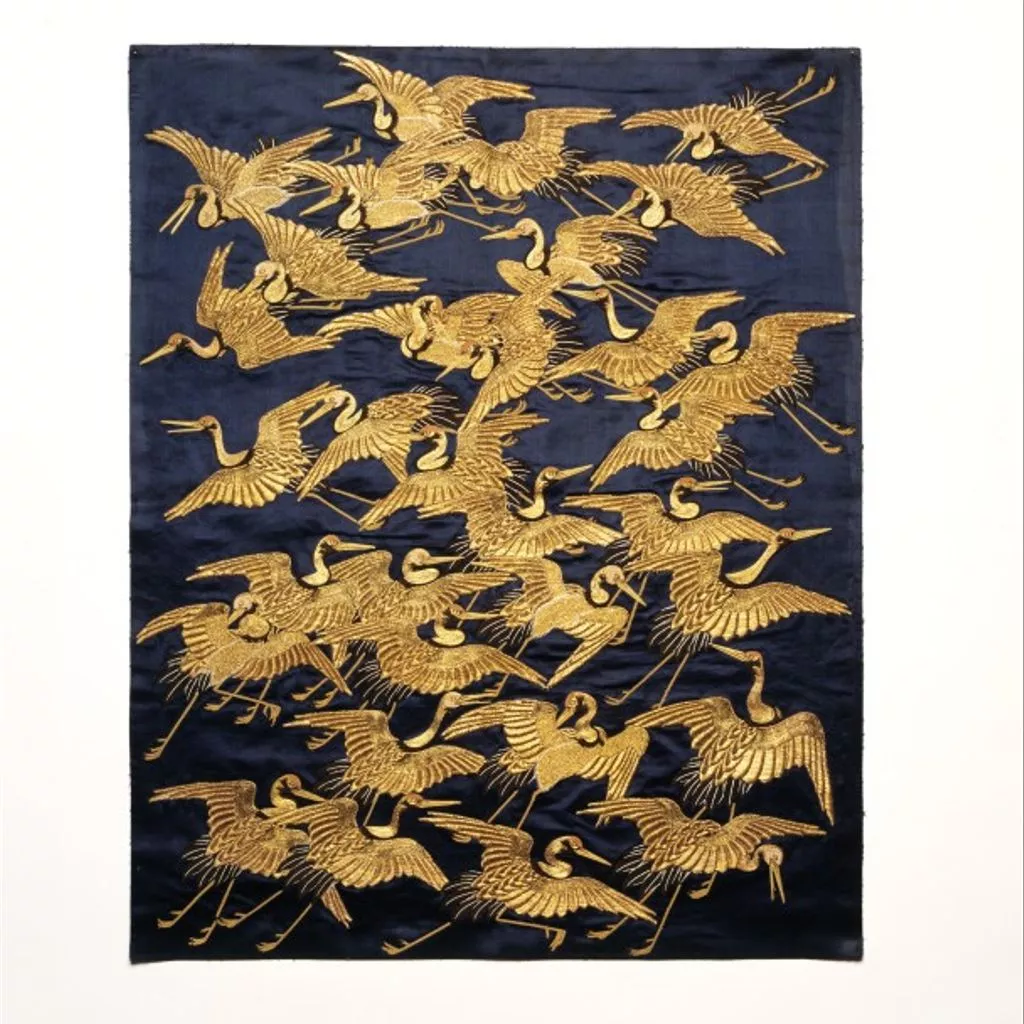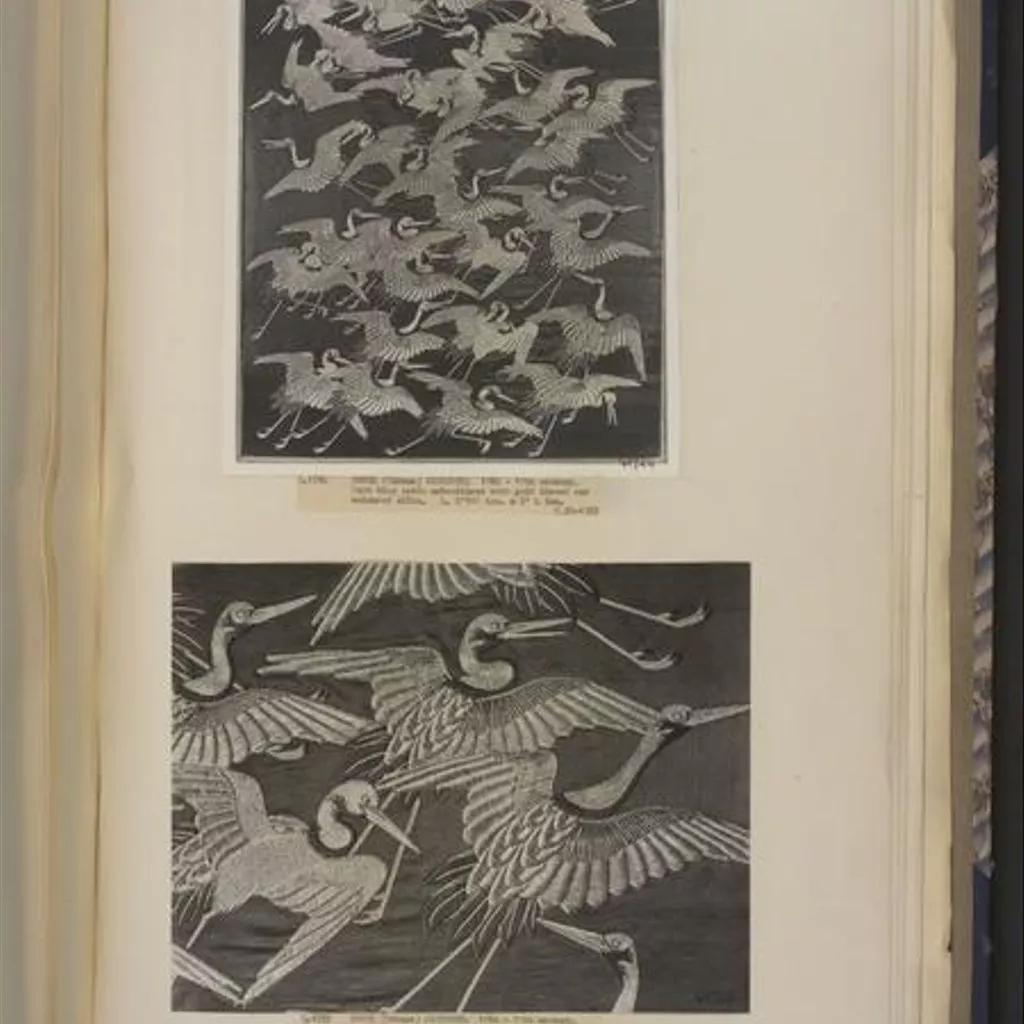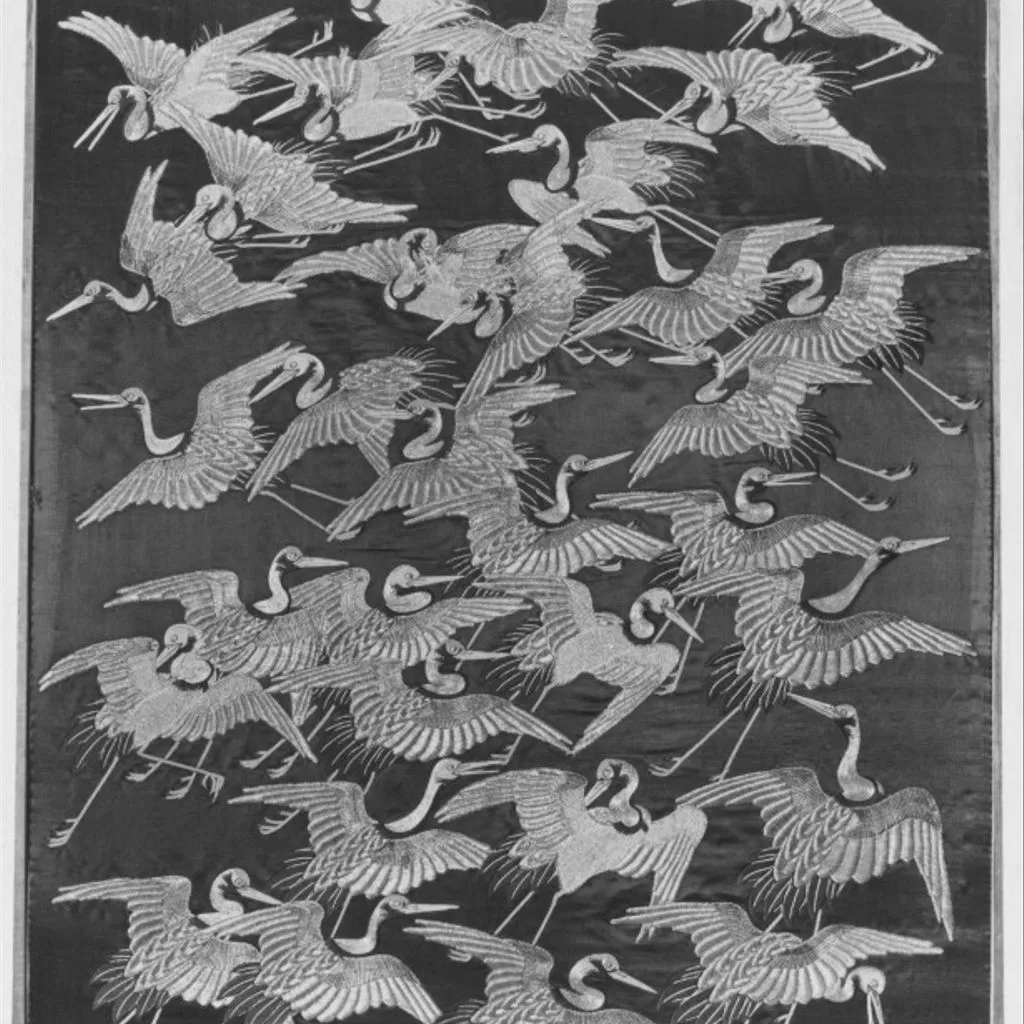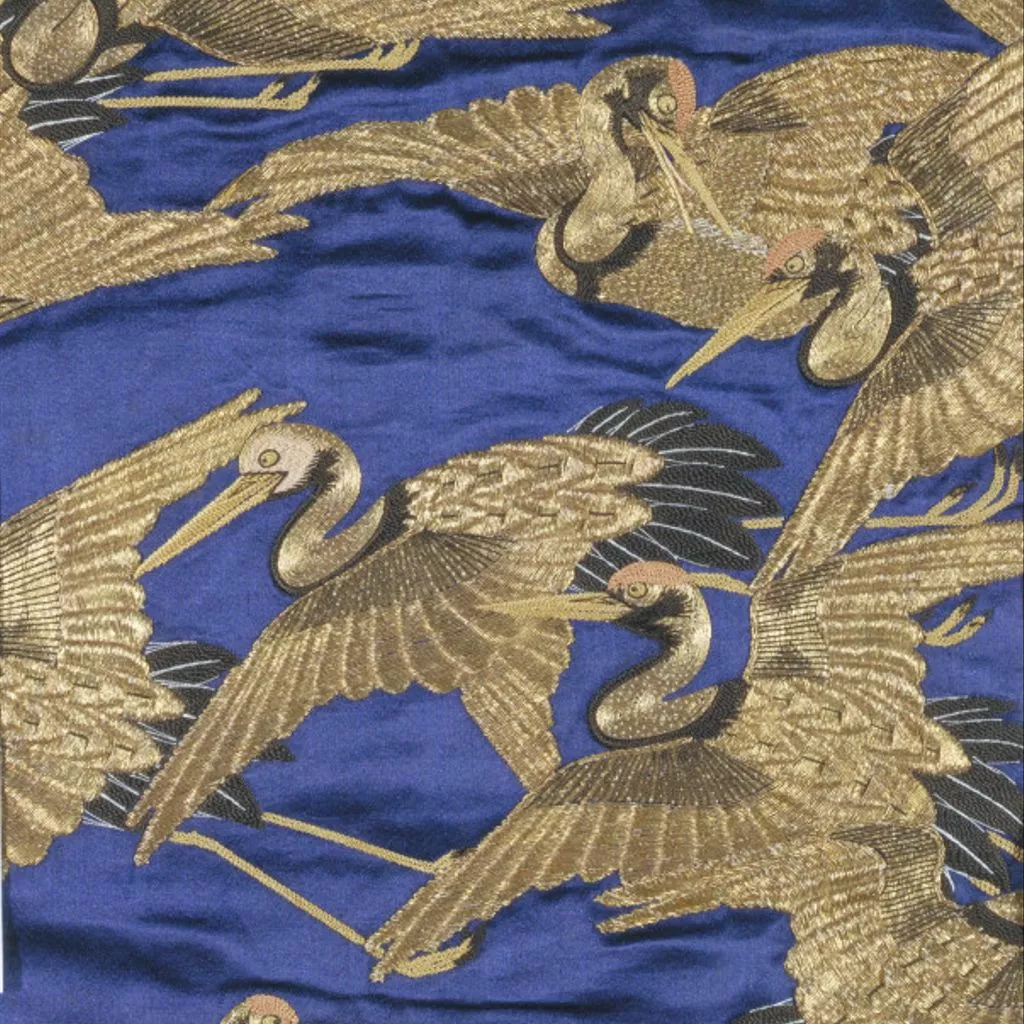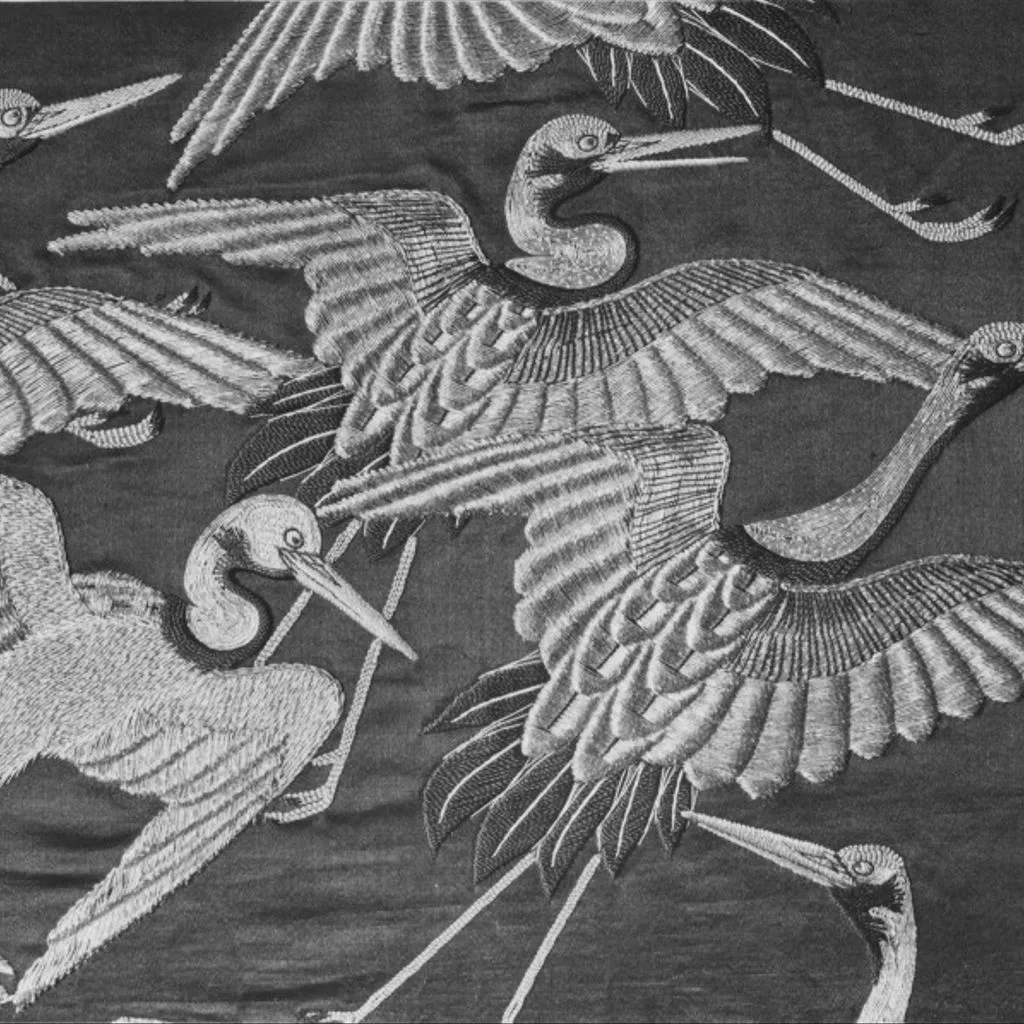Description
Fukusa (gift cover) of blue satin-weave silk, embroidered with coloured silks and gold wrapped threads in satin stitch and couching. Decorated with a flight of cranes.
Fukusa (gift cover), satin silk with embroidery in silk and metallic thread, Japan, Edo period, 1840-70
Gift cover (fukusa)
1840–70
The flock of cranes decorating this gift cover (fukusa) conveys wishes for long life and happiness. The lavish design suggests a wealthy donor. It is executed almost totally in gold-wrapped thread, which is attached to the surface of the fabric with barely visible red stitches. The wings of the birds are padded to enhance the three-dimensional effect. The embroidery looks particularly striking against the dark blue satin ground. [68]
Probably Kyoto
Satin silk with embroidery in silk and metal-wrapped threads
Given by Mrs Watts
Museum no. T.20-1923
[04/11/2015]
Gift cover (fukusa)
Blue satin-weave silk embroidered with silk and gold wrapped threads in satin stitch and couching.
Japanese; c.1840-1870
T.20-1923
Watts Gift
The flock of cranes decorating this fukusa convey wishes for long life and happiness. Cranes were believed to live for a thousand years and to inhabit Mount Horai, the land of the immortals. They are one of the most common motifs in Japanese art. This fukusa would have been appropriate for celebrations of birthdays and weddings.
The design is executed almost totally with gold wrapped thread which is couched down with stitches that are virtually invisible to the naked eye. The wings of the birds are also padded. The embroidery looks particularly striking against the indigo blue background, which became a popular choice for fukusa from about 1850.
This fukusa was presented to an Englishman, William Rogers, at the Emperor's Palace in Japan in 1874. His sister gave it to the Museum in 1923. [December 1993]
A flock of flying cranes is embroidered in a raised and couched technique using gold-wrapped thread on an indigo-dyed, dark bleu satin. This fukusahas no lining. The cranes in the lower half are turning right and those on the upper half are turning left. This fukusawas donated by Mrs. Walts, whose brother, William Roger, was presented with it in 1874 at the "Mikado's Palace" in Japan.
In Japan since the early Heian period, 794-1184, cranes have been regarded as birds of longevity. This belief had it origin in China. In the Chinese Taoist book Huainanzi (Enangi in Japanese) written in the 2nd century BC, there is mention of "a thousand year old crane." The Chinese admired the crane for it beauty and regarded it as the companion of a legendary wizard. It later came to imply longevity. In Japan the crane is also loved for its elegant posture and its clear cry. In the Manyoshu, a collection of poems from 7th to 8th century, this cry is expressed as the "one cry of a crane," meaning the final voice of authority. The idea that the crane combines aspects of purity and naivete in its elegant features is derived from Taoist thought. There is a Japanese proverb, "the crane lives thousand years, and the turtle lives ten thousand years." The crane actually lives for about 80 years and therefore was considered to have a long life, especially when people had an average life span of 50 years. Since the crane continues to live in one place from generation to generation, it further promotes the idea of living for a long time. Hence, the crane and the turtle have become a highly revered symbol of longevity along with the sho chiku bai, pine, bamboo and plum. These patterns are commonly found not only on fukusa but also on art work and craft objects. The crane, as well as the turtle, is also associated with the sunrise, Mt. Fuji, sho chiku bai, auspicious clouds, the ocean, waves, the character of kotobuki etc., in order to express a sense of purity and longevity on a happy occasion. The crane is also a symbol of conjugal harmony as implied by its dance at breeding time and two cranes together express conjugal bliss. At this time, according to legend, one has an open beak while the other has a closed beak, as an expression of a'un. (See p. 270)
Often the crane is shown in flight with a strip of paper attached to its leg. This motif is based on the legend of Minamoto Yoshitomo (1123-60?), and his son, Yoritomo who put gold plates on crane's legs when they flew from Yuigahama beach. The cranes flew back to Tazawa in Shizuoka prefecture hundreds of years later. In another story the lord of the Ii family in Hikone captured the cranes. This motif or design symbolises the long life of the crane.
This fukusa with a flock of flying cranes is a good omen, many kotobuki, or a hundred kotobuki, which is appropriate for any celebration.
(Quoted from Takemura, Akihiko. Fukusa : Japanese gift covers, 1991. Mr Takemura had studied the fukusa collection at the Museum in 1990.
This textile cover is called a ‘fukusa’. Traditionally in Japan, gifts were placed in a box on a tray, over which a fukusa was draped. The choice of a fukusa appropriate to the occasion was an important part of the gift-giving ritual. The richness of the decoration was an indication of the donor’s wealth, and the quality of the design evidence of his or her taste and sensibility. This satin fukusa is embroidered in silk and metallic threads with an image of cranes. These birds are a symbol of longevity, for they are believed to live for 1000 years.





